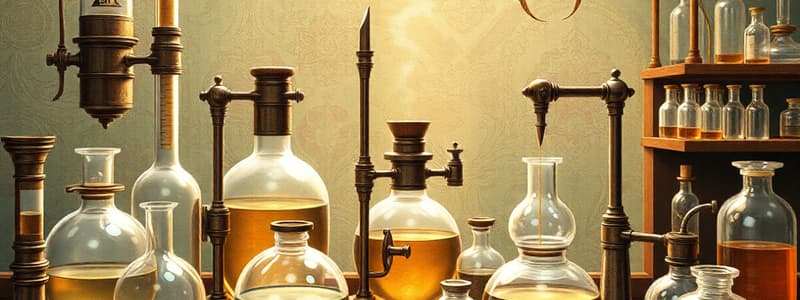Podcast
Questions and Answers
What is the primary purpose of a test tube in a laboratory?
What is the primary purpose of a test tube in a laboratory?
- To hold, mix, or heat small quantities of chemicals (correct)
- To store large amounts of solid materials
- To measure liquid volumes precisely
- To transport gases safely
What distinguishes a graduated cylinder from a beaker?
What distinguishes a graduated cylinder from a beaker?
- Graduated cylinders cannot be used for chemical reactions.
- Graduated cylinders are used for measuring liquid volume with greater accuracy. (correct)
- Graduated cylinders can only hold fixed volumes.
- Graduated cylinders are more suitable for mixing solids.
What is a unique feature of flasks compared to other laboratory containers?
What is a unique feature of flasks compared to other laboratory containers?
- They are exclusively used for mixing solids.
- They have a wider body and a narrower neck. (correct)
- They never have a top opening.
- They can only be used for volumetric measurements.
Which laboratory equipment is primarily used to support test tubes during experiments?
Which laboratory equipment is primarily used to support test tubes during experiments?
In what situation would a cuvette be specifically utilized?
In what situation would a cuvette be specifically utilized?
What principle does a centrifuge operate on to separate particles in a sample?
What principle does a centrifuge operate on to separate particles in a sample?
How does a spectrophotometer determine the concentration of a light-absorbing substance in a sample?
How does a spectrophotometer determine the concentration of a light-absorbing substance in a sample?
What is the primary function of a thermal cycler in laboratory procedures?
What is the primary function of a thermal cycler in laboratory procedures?
What purpose does a UV transilluminator serve in a laboratory?
What purpose does a UV transilluminator serve in a laboratory?
What type of measurements is a balance designed to perform in a laboratory setting?
What type of measurements is a balance designed to perform in a laboratory setting?
Flashcards are hidden until you start studying
Study Notes
Laboratory Equipment
- Laboratory equipment is used by scientists to conduct experiments, take measurements, and gather data.
- Examples include test tubes, flasks, beakers, pipettes, and centrifuges.
Test Tubes
- These are finger-like tubes of glass or plastic, open at the top, with a rounded bottom.
- They are used to hold, mix, and heat small quantities of solids or liquids.
Racks or Holders
- These are used to support and hold test tubes, pipettes, and other equipment.
- They are essential for storing and organizing test tubes.
Flasks
- They are characterized by a wider body and a narrower neck with an opening at the top.
- They are used to hold, contain, collect, and sometimes measure chemicals, samples, and solutions.
Beakers
- They are cylindrical containers with a flat bottom and a small spout for pouring.
- They are available in various sizes, from 1 mL to several liters.
- They are used for mixing and heating liquids.
Graduated Cylinders
- They are used to measure the volume of liquids.
- They are generally more accurate than flasks and beakers.
Pipettes
- These are tools used to transport a precise volume of liquid.
- They can be divided into micropipettes and glass pipettes.
Micropipettes
- These are used to transport small volumes of liquid, ranging from 1 µL to 1000 µL.
- There are two types: fixed and adjustable.
Glass Pipettes
- Traditional glass pipettes are used to transfer larger volumes of liquid.
Eppendorf Tubes
- They are small, conical tubes mainly used for holding and centrifuging small volumes of liquid, typically used with micropipettes.
Cuvettes
- They are small tubes with a circular or square shape, typically made of plastic or glass.
- They are designed to hold samples for spectroscopic experiments.
- They can be open to the atmosphere or have a cap to seal them.
Centrifuges
- They are used to spin samples at high speeds, causing heavier particles to settle to the bottom of a tube.
- They are used for separating different components of a mixture.
- There are two types: centrifuges for test tubes and microcentrifuges for Eppendorf tubes.
Spectrophotometers
- These instruments measure the amount of light that passes through a sample, providing information about the concentration of a substance in the sample.
- They typically consist of a spectrometer and a photometer.
Water Baths
- They are containers filled with heated water, used to incubate samples at a constant temperature.
Vortex Mixers
- These devices are used to mix small vials of liquid by creating a vortex motion.
UV Transilluminator
- This device projects UV radiation, used to visualize DNA or RNA stained with fluorescent dyes.
Thermal Cycler
- It is used to amplify segments of DNA via polymerase chain reaction (PCR).
- It heats and cools the sample to specific temperatures, which allows for DNA amplification.
Balance
- It is designed to measure small masses in the sub-milligram range and is usually enclosed to prevent dust and air currents from affecting the measurement.
pH and Temperature Meter
- It measures the hydrogen ion concentration in a solution, indicating its acidity or alkalinity.
- It can also measure the temperature of the solution.
Gel Electrophoresis
- This technique is used to separate charged molecules, such as DNA and proteins, based on their size and charge.
- It utilizes an electrophoresis unit with electrodes, a power supply, buffer, and a supporting medium, typically a gel.
Studying That Suits You
Use AI to generate personalized quizzes and flashcards to suit your learning preferences.




